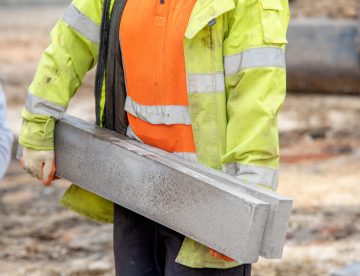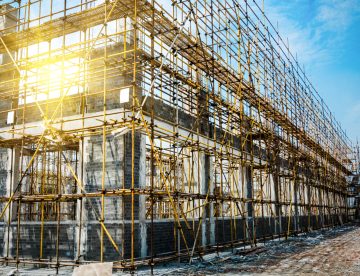
If you’ve been working on a construction site in Britain for a while then it’s very likely you’ll have the had many experiences of working in rainy conditions.
While the odd shower isn’t so bad, persistent rain can result in some pretty unpleasant working conditions on site (and in other outdoor working environments). As well as posing a number of risks associated with workers getting cold and wet, rain can increase the chances of people falling victim to other hazards like slips, falls and accidents caused by poor visibility.
As we’ve had a few Autumnal downpours over the past few days, in this week’s blog, we’re talking about the dangers associated with working in rain and what steps can be taken to stay safe.

Manufacturing industries have been developing and using robotics for several decades, the first example being a robot that was capable of transferring objects from one point to another within a distance of around three and a half metres, designed by George Devol in 1954.
Jump forwards to today and intelligent robots have taken over many of the manufacturing tasks that require high precision, speed and endurance. They are becoming smarter, more flexible and increasingly capable of working independently of humans. It’s safe to say that, without robots, most large manufacturing companies would struggle to survive.
With such advancement taking place in one sector, we thought we’d take a look at what’s happening in construction. Read on to find out three ways in which our industry is joining the robotic revolution.

Lifting and moving heavy objects are part of normal working life on construction sites but, when managed badly, these everyday tasks can lead to damaging musculoskeletal disorders that leave workers struggling to stand, walk or sit down. For some, the injuries result in them having no option but to stop working in the industry altogether.
Because the health of workers can be affected to such a serious degree, inspectors from the Health and Safety Executive will be carrying out 1000 site inspections in October and November, particularly checking how workers are moving heavy or bulky materials. Read on for more details.

One day last week, our Managing Director was in attendance at two separate awards ceremonies and, although he was there as a guest rather than a nominee, he did find himself by the winners side at both events.
One of the winners was a carpentry firm that won a supply chain award with a well-known contractor and the other was a charity that won a BBC Three Counties Make a Difference award. Clearly these were two very different organisations but it was interesting to observe them as they both took on the ‘award winning’ accolade.
Here at Sheriff Construction, we’ve been recognised at industry awards in the past but witnessing two new winners all on one day made us wonder about the benefits that such awards offer and whether there are key qualities that make a ‘winner’. Read on to find out more.

For most tradespeople, their van is not only a means of getting to and from work but also a vital part of their livelihood, holding many of the tools and materials they need to fulfil the day’s work.
How you fit out and organise your van can make a big difference in terms of the lifespan of your tools and equipment and also how efficient you are able to be on the job. With theft from vans being quite common, security is another major concern.
This week, we’re sharing five tips which could help you make sure your van is practical for your needs, well-organised and secure – in other words, fit for work.

Whether it’s a small-scale conversion project or a large commercial development, the contractors and sub-contractors involved will have an impact on the community they’re entering into.
In all likelihood, the work will be carried out in a location where some people live, work or spend their leisure time and that means there are several areas of concern which should be taking into consideration – particularly the appearance of the site, noise control and the logistical arrangements.
How members of the public react to these impacts will largely depend on how well a contractor engages with them. So, in this week’s blog, we’re exploring why keeping good relationships with local communities is so important to the success of any building project and what can be done to maintain a reputation as a considerate contractor.

On 6th September, Liz Truss formerly became the UK’s 80th Prime Minister, moving into number 10 Downing Street and no doubt inheriting an in-tray as high as some of London’s skyscrapers!
In her debut speech as PM, Truss talked about her vision for an “aspiration nation” characterised by tax cuts and business-led growth, and talked about three priorities – tackling the energy crisis, supporting the NHS and boosting the economy. Claiming her mission was to “get the UK working, building and growing’, the new Prime Minister gave little detail of how that might come about and interestingly made no references to net zero, nature or climate change.
With the construction industry facing economic challenges around rising costs plus labour and materials shortages alongside environmental challenges around emissions, energy efficiency and waste, industry leaders have been quick to react to the new PM’s appointment. In this week’s blog, we’re sharing what some had to say.

With the August bank holiday weekend coming up, some people will be taking this opportunity to get away for the last time before the ‘back to school’ season kicks in. Others, however, will be doing that other thing we Brits seem to love to tackle on bank holidays – a bit of DIY!
That often means decorating or carrying out refurbishments inside the home but have you thought about the exterior – the walls, doors, windows, lighting and roof? After all, it’s the state of these things that makes a first impression on anyone who visits your home and it’s also worth remembering that any wear and tear not only looks bad but can be costly, causing energy loss and perhaps more expensive repairs if left unresolved for too long.
In this week’s blog, we’ve got four things you could do to improve the exterior of your home.

Across the world, people from all continents are witnessing the destructive effects of climate change – droughts, floods, wildfires, extended heatwaves. storms and crop failures.
When you consider this, alongside the rocketing increases in energy prices that’s causing many households and businesses to struggle with their bills, it’s clear that reducing the amount of energy we all use is now urgent – for both our planet and our purses.
One solution that we’re hearing mentioned more frequently within the construction world is the ‘Fabric First’ approach – changes that can be made when considering the design, construction and ‘fabric’ of a building to ensure it becomes energy efficient. In this week’s blog, we’ll tell you more.

